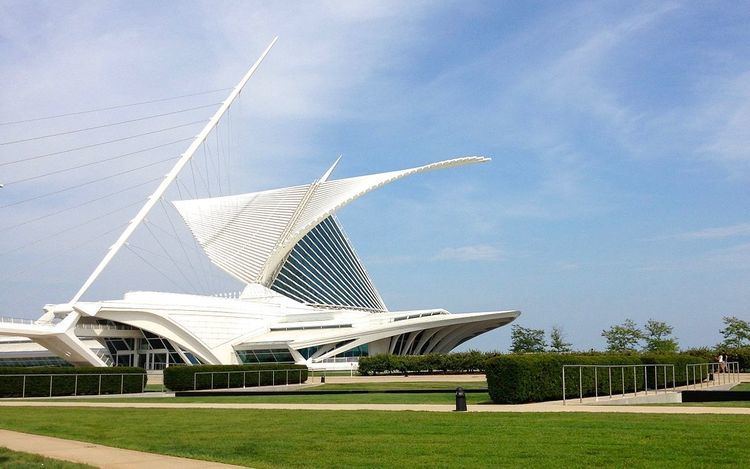Established 1882 Visitors 400,000+ Phone +1 414-224-3200 | Website www.mam.org Founded 1888 | |
 | ||
Director Marcelle Polednik 2016 - currentDan Keegan 2008-2016David Gordon 2002-2008 Hours Closed now Wednesday10AM–5PMThursday10AM–8PMFriday10AM–5PMSaturday10AM–5PMSunday10AM–5PMMondayClosedTuesday10AM–5PMSuggest an edit Similar Milwaukee Public Museum, Discovery World, Milwaukee Institute of Art & Desi, Museum of Fine Arts - Houston, Museum of Wisconsin Art Profiles | ||
Time lapse milwaukee art museum calatrava burke brise soleil hd
The Milwaukee Art Museum (MAM) is an art museum in Milwaukee, Wisconsin. Its collection contains nearly 25,000 works of art. It is one of the largest museums in the country.
Contents
- Time lapse milwaukee art museum calatrava burke brise soleil hd
- Milwaukee art museum part one
- Origins
- Kahler and Calatrava Buildings
- 2015 Expansion
- Collection
- Management
- Controversy
- References
Milwaukee art museum part one
Origins
Beginning around 1872, multiple organizations were founded in order to bring an art gallery to Milwaukee, as the city was still a growing port town with little or no facilities to hold major art exhibitions. Over the span of at least nine years, all attempts to build a major art gallery had failed. Shortly after that year, Alexander Mitchell donated all of her collection into constructing Milwaukee's first permanent art gallery in the city's history.
In 1888, the Milwaukee Art Association was created by a group of German panorama artists and local businessmen. The same year, British-born businessman Frederick Layton built, endowed, and provided artwork for the Layton Art Gallery, now demolished. In 1911, the Milwaukee Art Institute, another building constructed to hold other exhibitions and collections, was completed. The institute was built right next to the Layton Art Gallery.
The Milwaukee Art Museum was Milwaukee's first (disputed, Layton opened that same year) art gallery, opening in 1888.
The Milwaukee Art Center (now the Milwaukee Art Museum) was formed when the Milwaukee Art Institute and Layton Art Gallery merged their collections in 1957 and moved into the newly built Eero Saarinen-designed Milwaukee County War Memorial.
Kahler and Calatrava Buildings
In the latter half of the 20th century, the museum came to include the War Memorial Center in 1957 as well as the brutalist Kahler Building (1975) designed by David Kahler and the Quadracci Pavilion (2001) created by Spanish architect Santiago Calatrava.
The Quadracci Pavilion contains a movable, wing-like brise soleil that opens up for a wingspan of 217 feet (66 m) during the day, folding over the tall, arched structure at night or during inclement weather. The pavilion received the 2004 Outstanding Structure Award from the International Association for Bridge and Structural Engineering. This iconic building, often referred to as "the Calatrava," is used in the museum logo.
2015 Expansion
In November 2015, the museum opened a $34 million expansion funded jointly by a museum capital campaign and by Milwaukee County. The new building, designed by Milwaukee architect James Shields of HGA, provides an additional 30,000 square feet for art, including a section devoted to light-based media, photography, and video installation. The building includes a new atrium and lakefront-facing entry point for visitors and was designed with cantilevered elements and concrete columns to complement, respectively, the existing Calatrava and Kahler structures on the site. The final design emerged after a lengthy process that included the main architect's departure because of design disputes and his return to the project.
Collection
The museum houses more than 35,000 works of art housed on four floors, with works from antiquity to the present. Included in the collection are 15th- to 20th-century European and 17th- to 20th-century American paintings, sculpture, prints, drawings, decorative arts, photographs, and folk and self-taught art. Among the best in the collection are the museum's holding of American decorative arts, German Expressionism, folk and Haitian art, and American art after 1960.
The museum holds one of the largest collections of works by Wisconsin native Georgia O'Keeffe. Other artists represented include Gustave Caillebotte, Nardo di Cione, Francisco de Zurbarán, Jean-Honoré Fragonard, Winslow Homer, Auguste Rodin, Edgar Degas, Claude Monet, Henri de Toulouse-Lautrec, Frank Lloyd Wright, Pablo Picasso, Joan Miró, Mark Rothko, Robert Gober, and Andy Warhol.
It also has paintings by these European painters: Francesco Botticini, Antonio Rotta, Jan Swart van Groningen, Ferdinand Bol, Jan van Goyen, Hendrick Van Vliet, Franz von Lenbach ("Bavarian Girl"), Ferdinand Waldmüller ("Interruption"), Carl Spitzweg, Christian Bokelman ("Broken Bank"), Bouguereau, Gerome ("2 Majesties"), Gustave Caillebotte, Camille Pissarro, Alfred Kowalski ("Winter in Russia"), Jules Bastien-Lepage's "The Wood Gatherer", and Max Pechstein.
Management
From 2002 to 2008, the director and CEO was David Gordon.
As of 2015, the museum’s endowment is around $65 million. Endowment proceeds cover a fraction of the museum's expenses, leaving it overly dependent on funds from day-to-day operations such as ticket sales. Daniel Keegan, who has served as the museum's director since 2008, negotiated an agreement with Milwaukee County and the Milwaukee County War Memorial for the long-term management and funding of the facilities in 2013.
Controversy
In June 2015 the museum's display of a work depicting Benedict XVI created outrage among Catholics and others.
